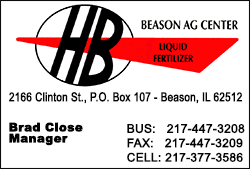|
 What will Logan County farmers be planting? What will Logan County farmers be planting?
Previous years indicate that the corn production will remain a high
priority for the majority of farmers in Logan County. For some
farmers, the trend of continuing to grow corn instead of switching
to beans (also known as corn-on-corn production or continuous corn)
is appealing.
The trend began in 2007, when Logan County corn acreage peaked at
231,500 harvested acres, producing a record 197 bushels per acre.
The following two years resulted in slightly lower yields of 188
bushels per acre, a number that fell drastically to 155.7 in 2010.
The most recent 2014 season, Illinois set a new record of 200
bushels per acre; 22 bushels higher than the 178 bushel average of
2013.
Logan County did considerably better than the state for the 2014
season, averaging 230.8 bushels per acre.
According to data released in February by the National Ag Statistics
office, Logan County farmers planted 201,500 acres of corn. Out of
that total 200,000 acres were harvested.

Soybeans
As for soybeans in 2014, Logan County farmers planted 136,500 acres
of soybeans. 136,300 acres were harvested with an average yield of
63.7 bushels.
So what is the broad overview of corn vs soybeans?
Continuous corn
Corn is known for typically being more profitable when compared to
soybeans at harvest time. But is that profit without risk? In order
to answer that, we need to look at a few factors involved in
planting continuous corn.
A factor to consider is the presence of fertilizers and pesticides.
Potential profits are affected by the quantity of necessary
fertilizers and pesticides used. Soybeans replace some of the
nutrients that corn takes from the soil. As a result, there is a
potential for a reduced need for fertilizers.
On the topic of nutrients in the soil, there is a belief held by
some farmers that continuous soybean planting may be just as risky
as continuous corn planting. According to a May 2014 news release
from Illinois Farmer Today, soybeans planted after soybeans may be
less resistant to disease and more taxing on the soil.
On the other hand, corn that is planted after a pervious corn crop
may be less resistant to disease and more susceptible to cob rot; as
opposed to corn planted after soybeans, that corn may be more
resistant.
Continuous corn planting also carries the risk of yield drag as the
harvest numbers decrease due to diminishing returns.

Soybeans, while still reduced in harvest numbers after continuous
planting, do not experience the same level of loss at harvest.
Another factor to consider is the value of cash rent
The 2014 USDA report reveals that Logan County had the highest cash
rent in Illinois at $308 per non-irrigated acre. Farmers paying
higher cash rents to landowners in past years continued growing corn
to earn a greater profit for themselves.
Soybeans, despite selling at higher prices, are not subject to the
same level of demand as corn, and average yields are generally much
lower.
Comparatively, corn is typically chosen over soybeans as it offers
broader marketability and its higher yields sufficiently make up for
corn’s lower price. The strategy of continuous corn sounds
counter-productive when compared to the typical methods of crop
rotation. According to the 2012 crop budget report provided by the
University of Illinois Agricultural Department, greater gross
revenue will result from the planting of soybeans after two years of
planting corn.
[to top of second column] |
 According to a five-year study conducted by the U of I and
published in 2013:
“The data for 2013 indicates that there was little if any yield
advantage or disadvantage of a higher percentage of corn acres…
- Higher percentages of corn production leads to increased
costs per acre for fertilizer, pesticides, and seed as
represented by the increasing disadvantage of the higher corn
percentages.
- Power and equipment cost exhibited this same trend.”
The study concluded that the data (see table- provided by the
University of Illinois Ag Extension) for 2013 suggests that
revenue was higher at the higher percentages of corn acres, but
there was a greater cost to produce that increase.
As is the case with any business model, the desire for greater
profits is the reason for the use of continuous corn planting in
the fields.
In summary, the continuous planting of soybeans comes with
similar risks, but they may not be as steep as once thought.
Overall, corn is a more profitable crop, but it makes greater
financial sense in the long term to plant beans for a year (or
possibly more) after three or four years of corn.
If all corn and soybean acres in Logan County were on rotation
and practicing two years corn, one year soybeans, on the 338,000
acres planted last year the multi-year averaged split would be
225,333 acres corn and 112,666 acres soybeans. Last year’s
records show that Logan County farmers planted 201,500 acres
corn to 136,500 acres soybeans.
 Logan County 2014 production was considerable better than the
state averages on both corn and soybeans.
| Crop |
State Avg.
Bu/Acre |
Logan Co
Bu/acre |
| Corn |
200 |
230.8 |
| Soybeans |
56 |
63.7 |
The farmer must also consider numerous factors in each year's
planting choice: results of last year's harvest, fertilizer
needs, prior year weeds and diseases, projected costs and market
demands.
Articles cited
Is There An Advantage To More Corn Acres in Your Rotation?
Farmers love corn too much to grow continuous soybeans
 |